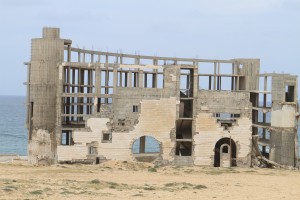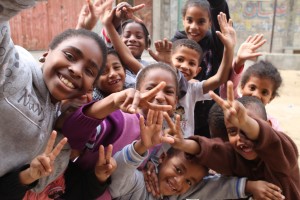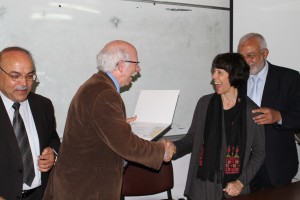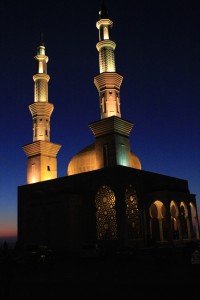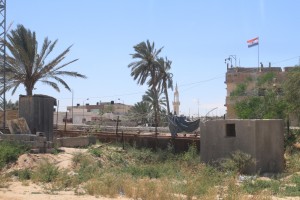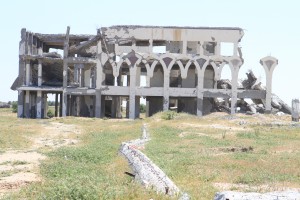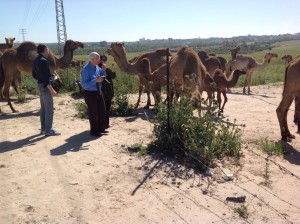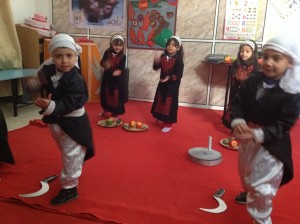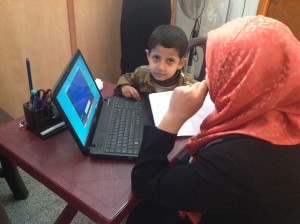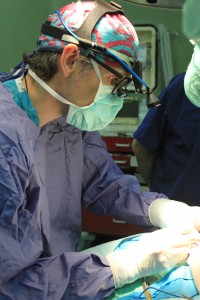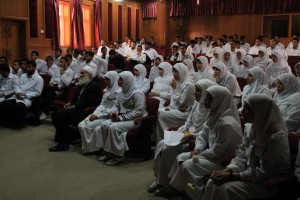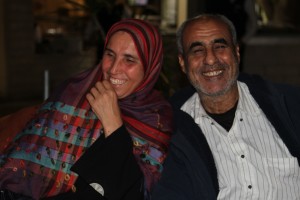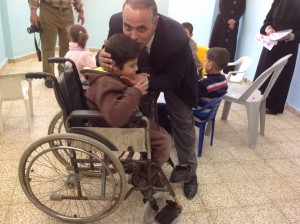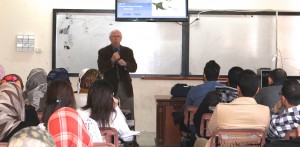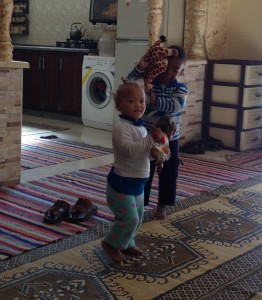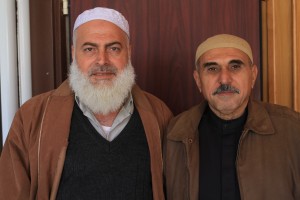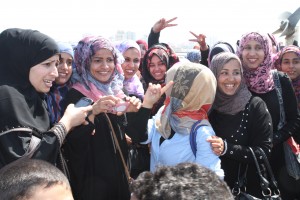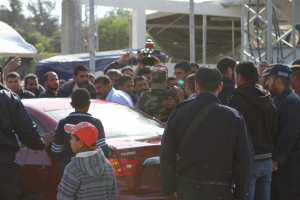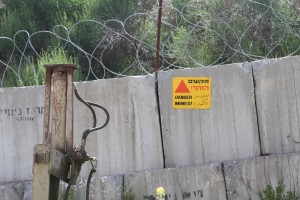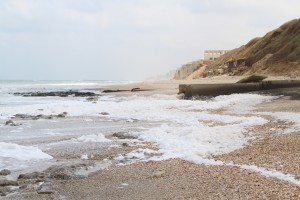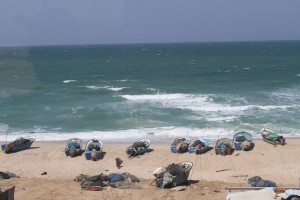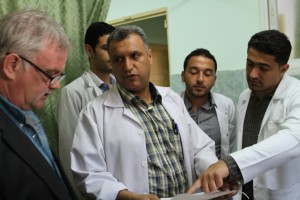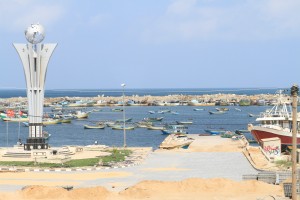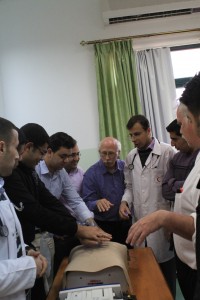(Washington Physicians for Social Responsibility has been sponsoring delegations to Gaza since 1993. In 2009, the group began offering medical service work to the people of Gaza.)
Saying “Farewell” to friends – friends we have returned to and friends we have just met – is unsettling. We are so very thankful for this time in Gaza and wish the imprisonment of nearly two million wonderful people would end.
Rich and Grant spent today at Al Shifa hospital consulting on medical exams, Chuck and Don and Laura saw patients. Bob and Laura and I visited the Palestinian Medical Relief Society clinics in the northern part of Gaza. We learned more about the service this organization is doing in primary care throughout Gaza and were impressed by the dedication of the staff of these clinics. From the Bedouin villages in the north and south through the refugee populations in Jabaliya and other camps, the PMRS physicians are providing primary health care to underserved populations.We discussed the rate of
Caesarian births in Gaza and were surprised to learn that the choice for Caesarian birth seems to be increasing here as it has in the United States. Because health statistics are not fully recorded here, it was not possible to get rates for this or answers to many other health statics questions we raised: Number of patients with Thalassemia, number of children born with Down Syndrome, etc.In a situation where computer equipment is difficult to obtain and maintain, it is hard to quantify the prevalence of any disease or condition. The single exception to this: The rate of vaccination for communicable childhood diseases is 100% – children are not allowed to attend school without a current
record of vaccination and families come routinely to the clinic on their vaccination anniversary for scheduled updates.This afternoon, Bob and I returned to a northern Gaza area where a dear friend lives. She and her friends particularly like the homemade chocolates that our Kirkland neighbor, Susan, makes and sends with us each time we visit Gaza. I was so happy to be able to give my friend and her family some of this delicious treat again!
She is a nurse, will have a Caesarian birth later this month – her third child in four years. We hope this third Caesarian will go beautifully.
Tonight, we said “Good-bye” to many of the colleagues we have worked with during the past week-plus. Our host, the Gaza Community Mental Health Programme has facilitated our visits each day and we are deeply grateful to Abu Husam and the GCMHP staff.Traffic in Gaza is amazing – hundreds of thousands of people moving rapidly through the streets (cars, trucks, donkey carts, pedestrians) and rarely a traffic light, street sign or patrol person. Without the guidance of GCMHP, we would have been lost!!
Tomorrow, we will pass again through the Erez checkpoint and go to Bethlehem. We’re planning to work with the Palestinian Medical Relief Service for several days in the West Bank before we fly home next week. We are grateful for this time in Gaza… When will we be here again?
(Washington Physicians for Social Responsibility has been sponsoring delegations to Gaza since 1993. In 2009, the group began offering medical service work to the people of Gaza.)
The Call to Prayer awakens us each morning at about 4:30 – through our window, we hear calls from many different mosques – the sound is beautiful. Through the call comes the song of several roosters – morning in Gaza.
Today being Friday, the clinics are closed and we were treated to a van trip to the western, eastern, and southern borders of Gaza. We looked down at the sea to observe some of the 90 million liters of partially or fully untreated sewage that flows each day into the Mediterranean from Gaza. We stood on the edge of the 35% of arable land in the east that is called the “no go zone” – that part of Gaza forbidden to normal traffic or to the growing of historically tall crops. This land borders Israel and is considered by Israel to be a security buffer zone. Trees have been eliminated here and only on the furthest west part of the zone do farmers plant low-growing crops…crops that provide no shelter from Israeli observation. Israeli border guards shoot farmers wandering “too far” into this area.We visited the Gaza airport – once a hopeful sight whose opening was celebrated in person by President Bill Clinton, the airport is destroyed. No planes fly in or out of Gaza – the airspace is controlled by Israel and Israeli warplanes, drones and observation balloons fly regularly over Gaza. We stopped at the Rafah border with Egypt – since the change of government in Egypt, this border is now often closed. And then we visited the tunnel area. At their peak, hundreds of tunnels were used for the importation of goods from Egypt to Gaza. In the last six months, the tunnels have been destroyed by Egypt and the effect of their loss has had a devastating effect on the economy of Gaza – jobs lost, the price of goods increased, fewer goods available, etc. Life in a prison.
And then, this afternoon, an inspiring young man who is a nurse in a local hospital came to visit us. He and his friends are working on two projects. The first involves continuing education for nurses and the second is a support project for children – providing the children with joyful activities in an effort to relief the suffering of life. We will learn more about these projects!
Grant O’Keefe wrote the following – we are deeply grateful to have Grant on our “team.”
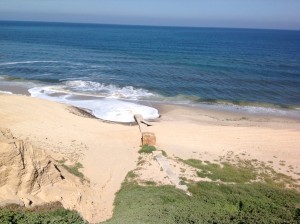
Some 90 million liters of partially or fully untreated sewage flows each day into the Mediterranean from Gaza.
“Every person I have spoken with has a different story, of course, but there are a few things that are remarkably similar. First is the importance and love of family and children. Everyone is so gentle and patient with children; this in an environment that would otherwise not seem to foster either. Second is that everyone here feels abandoned by the rest of the world; they are living in the world’s largest prison. Among all their needs, almost everyone asks that we tell the rest of the world about the terrible situation in Gaza and also that “we are not all terrorists”. I have heard this exact phrase more often than I could count.
“You might assume that medical care isn’t terrible given that the patients I have seen come with CT scans and MRIs, both of which are available in the hospitals in Gaza. This assumption is wrong. The surgeons here are operating with instruments that are almost unusable, in gowns that are torn and wearing thin, and have little access to supplies and medicines that are inexpensive, should be easily available and are necessary to practice surgery safely.
“The pace of work here is not tiring for me nor is it excessive, yet, today, I am exhausted. I need to be alone to recharge and to try to sort out all of this. Introverts will empathize, but this time it is more extreme.”
(Washington Physicians for Social Responsibility has been sponsoring delegations to Gaza since 1993. In 2009, the group began offering medical service work to the people of Gaza.)
Our various medical work continues: operating, consulting, teaching. We have traveled the length of Gaza (about the length of Lake Washington’s 27 miles) and visited with people along the way. The strong sense of family here helps us to understand how this population can endure and grow even while living under the constant threat of armed attack. The sound of fighter planes overhead reminds us that the threat is real.
This evening, Grant O’Keefe and Rich Grady each gave a talk at a Surgical Society Meeting. We were told how much it means to have colleagues from “the outside” join them here in Gaza as “we can’t get out to see you.”
Dr. Don Mellman wrote this today:
People are like tea bags; you never know how strong they are until they are in hot water. Source forgotten.
In this my fourth, or is it my fifth, trip to Gaza? I have been able to put the various issues that are raised into a perspective that is both historical and philosophical. The time spent in the sun and heat while waiting to just “enter” the wall erected by Israel to physically complete and represent its siege and occupation of Gaza, and the approximately three-quarters of a mile metal-enclosed trek that the Gazan authorities now willingly accept as the “cost of entry.” And, while I am at it, Israel’s Alice in Wonderland denial of the words “siege” and “occupation” to describe its treatment of Gaza brings the unsustainability of its actions into a stark “black comedy” reality.
Since my first trip into this surreal absurdity of “man’s-inhumanity-to-man,” I have thought much of Gaza and created formal presentations to several different audiences, which has forced me to articulate my ideas into a coherency that otherwise I would not have.
During this trip I have, as before, evaluated clinic patients with neurosurgical issues, assisted in the operating room, met with medical and human rights functionaries as they discuss their frustrations, and given talks on relationships (a concept Gaza has helped me to understand as the most important issue in life). But more importantly, the connections (read “relationships”) I have made with Basil Bakr, a neurosurgeon at al Shifa Hospital, and Husam al Nounou, from Gaza Community Mental Health Programme, have led to invitations into their homes, where I have been allowed into their personal lives and to share their families and food.
Thus, I have been able to witness their inner strengths and resilience as they cope with the severe political and economic restraints imposed by the self-aggrandizing leaders of the internal Fatah-Hamas disputes, the external Israel-Palestinian conflict, and the not-so-peripheral world community.
(Washington Physicians for Social Responsibility has been sponsoring delegations to Gaza since 1993. In 2009, the group began offering medical service work to the people of Gaza.)
Today also, I learned more about the need for a children’s library in the central part of Gaza – an area that has had no library in the last thirty years. The wonderful woman who hopes to organize this library told me of generations of children growing up with no access to books – she hopes to remedy this!
Attention to mental health is a major concern for caregivers here. The continuous threat of attack and the loss of many relatives during recent wars on Gaza have rendered a population at risk for depression and other psychological troubles. I met with university staff who are creating mental health treatment clinics, hoping to alter the cultural sensitivity to mental illness.Bob Haynes spent today seeing patients at Al Shifa Hospital. He writes: Heroism is not seen only on a battlefield, unless you count Gaza as a battlefield. The air, water, streets, and sea are polluted. Supplies coming into Gaza are tightly restricted by Israel, with no goods flowing through the bombed tunnels from Egypt. The export of goods and agriculture from Gaza is severely limited. The economy is contracting from poor to worse, resulting in decreasing wages, rising unemployment and inability to purchase goods and services. And yet, the people of Gaza go on living life with good spirit and even good humor.
In my work at the hospital today, I witnessed a patient’s son as he fluffed the bed pillows and tenderly removed her shoes and socks and straightened her legs on the bed. He continued to tend to her throughout my visit. Her angina pattern has become unstable, accelerating to several times per day. Last week, she had one clogged heart artery opened at this hospital and a stent was placed. Another artery was left untreated, as the correct size stent was not available.
Doctors in multiple clinics on the same floor share one very old computer. When the computer reports that the hospital still does not have the correct sized stent to treat this patient, the doctor informs the patient and family that the stent will not be available for several weeks. After serious conversation in Arabic evolves to light-hearted tones then laughter, I ask what was said. The patient’s family and then the doctor shrug, “What can one do?” The doctor says, “Her son has just become engaged and the family is happy.” I am again amazed and inspired by the spirit of these people in the midst of the Gaza prison.
This evening, we gathered for the staff of Al Awda Hospital to say “Thank you”, particularly to Ismael Zamilpa who will leave Gaza tomorrow. In our conversation, one hospital physician summed up his feelings: “We are exhausted from suffering.”
This afternoon, we met with staff members of the Gaza Community Mental Health Programme to review our schedules for the remainder of our visit. Each encounter with these friends brings stories of the extreme difficulties of life in Gaza. While they live with courage, the prospect of the siege continuing into an increasingly future is hard to contemplate. A few examples of the public health burden: education is suffering – the lack of schools is profound; presently, 38 – 41% of the male population is unemployed; unless rapid reparations are accomplished (and nothing significant appears to be happening now), the Gaza aquifer will be damaged beyond repair by 2016 and there will be no drop of potable water in all of Gaza.
Tonight, the family of a Seattle couple joined our group for a visit at our hotel. We had a good time telling of our adventures and there was much laughter. Over and over, the strength of family is apparent here. We hear of young people leaving Gaza only to return to the tribal warmth of their family.
Many people in the US contributed money for the purchase of medicines badly needed for patients of the Gaza Community Mental Health Programme. This morning we delivered those medicines to GCMHP’s pharmacy – such a joy to be able to fill some of the pharmacy’s empty shelves. Thank you to all who made this possible!!
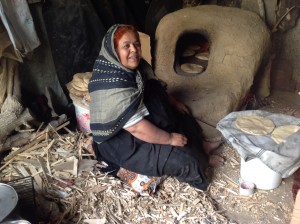 Laura Hart and I had wonderful opportunities to learn about Gaza from families served by GCMHP and by a great women’s group, AISHA. In central Gaza, we visited three families who are experiencing severe mental health challenges – depression, fear, anger – much of it closely related to the siege and to the constant threat of being attacked by Israel. In one humble home, we were treated to hot bread, pulled directly from the Tabool oven. The mother of the family (pictured here) arises at 3 AM each day to prepare food for her family, clean the home, and get her children ready for school.
Laura Hart and I had wonderful opportunities to learn about Gaza from families served by GCMHP and by a great women’s group, AISHA. In central Gaza, we visited three families who are experiencing severe mental health challenges – depression, fear, anger – much of it closely related to the siege and to the constant threat of being attacked by Israel. In one humble home, we were treated to hot bread, pulled directly from the Tabool oven. The mother of the family (pictured here) arises at 3 AM each day to prepare food for her family, clean the home, and get her children ready for school.
This afternoon, in visits to war-affected families, we heard tragic stories of the death or injury of family members. One very worried mother asked for the prayers of anyone we speak to – her son lost his eyes in a recent Israeli attack and is now in Egypt awaiting surgery. She is desperately worried about him.
Late this afternoon, we met with Scott Anderson of the United Nations Relief and Works Agency (UNRWA). Scott has served for six years in Gaza and acknowledged that lack of funding to the UN has resulted in the suspension of school feedings and the elimination of financial aid to families. (A woman told me last year that their monthly allotment of $100 from UNRWA was the family’s only income.) UNRWA provides food assistance to 860,000 people in Gaza. This agency works on many projects to aid Gazans – they provide schools for a majority of Gaza’s children, medical clinics and micro financing for encouraging entrepreneurs and the empowerment of women.
Earlier today, I asked Ismael Zamilpa, pediatric urologist, to write about his experience so far. He wrote:
“This is my third trip to Gaza. We have had the opportunity to continue our relationship with local surgeons and to see complex cases. We are trying to share our experience and opinions with them.
“The hospitality of the Palestinian people continues to be evident. They make us feel so welcome and are appreciative of our services. I hope the American public will get the chance to witness this instead of the frequent negativity reported on the news.”
In every meeting and nearly every encounter we are hearing about the life-threatening effects of the siege and the closure of the tunnels in Rafah. Shortages of medicine and hospital equipment routinely compromise medical care. We talked with women’s health leaders today. There is only one mammogram machine for all of the people served in Gaza through the public service. This is not a new machine and frequently needs repairs that are often not available. Still, the ingenuity of the dedicated medical care providers continues to be inspiring.
To more fully involve patients in their care, cards have been developed that show the patient the list of questions being asked by his/her physician during an interview. As the interview proceeds, the patient has the opportunity to continue to review the questions and responses. This process is proving to more fully inform and involve patients in their care. My editorial comment: we might consider this process for US health care!
Rich Grady and Ismail Zamilpa, pediatric urologists and Grant O’Keefe, general and trauma surgeon, are fully employed in surgical endeavors.
A visit to the cerebral palsy center – founded by Suhar Arafat and newly constructed was inspirational. The director, touring us through the building greeted children with great joy. The children, seeing him, obviously responded in a familiar and loving way to his attention. When I asked him if he loved his work, he said, “No.” He paused, then he said, “I adore it.” This photo of him cradling the face of a little boy does not adequately demonstrate the delight they both reflected when they first encountered each other today. Bob Haynes spent the day teaching advanced cardiac life support to medical students. He witnessed the dean of the medical school talking and joking with a group of students in a familiar and loving way – showing great interest and pride in them. Medicine here is a family-centered process.Each day we see friends from previous visits and are blessed to meet courageous citizens of Gaza who are working to make life more fulsome here. This evening, we talked with a young man who is staffing a project to have children employ donated cameras to document life in Gaza. They will show the world what the world is presently not seeing.
Our team has eight members: Rich Grady and Ismael Zamilpa (pediatric urologists), Laura Hart (adult urologist), Don Mellman (neurosurgeon), Chuck Cowan (pediatric autism specialist), Grant O’Keefe (general and trauma surgeon), Bob Haynes (cardiologist) and me. We parted in the morning with the surgeons and cardiologist in meetings and screening and consulting on patients and Chuck Cowan teaching.
I met with friends of several years – women who are experiencing the trauma of living in Gaza under siege. Again this year, I asked the women what they would like the people of the United States to know. Here are some of their responses:• We want the people of the world to know what is happening here – we think people would do something if they knew how bad things are. We are living in a prison.
• We need the siege to be ended.
• People in Gaza are angry and frustrated. We are without electricity much of the time. Even though we have a new technology – a rechargeable battery – it provides very little light and is expensive to charge.
• There is very little fuel and it is very expensive. With the tunnels closed, all of our fuel comes from
Israel and it is four times more expensive now than when we were able to get fuel through the tunnels from Egypt.
• My brother needs a liver transplant. This is not available in Gaza – he got permission to go to Egypt, but when he got to the crossing at Rafah, only two buses were allowed through and he was turned away – the crossing was closed again as it often is.
• There is no material for building – we would like to move, but there is no material for building. Fifty-eight people live in our house – which has seven tiny apartments.
• Most adults in the family have jobs, but the pay is very low
• The UN has cut the monetary support given to 70 – 80% of Gaza it serves and has stopped the distribution of food staples such as rice, sugar, and oil to many families.
• Cancer is increasing – we need specialty services – people have to be referred to Egypt or Israel, but this may not be granted.
• Hospital staff needs continuing education – if they leave for more education they may not be allowed to return.
• UN says school children need computers but the UN does not have the money to supply them and we cannot definitely afford to buy computers for our children.
Again, I was impressed by the courage and dedication of these women. The husband of one of the women had died recently and she and their four children had been taken into this crowded home. Somehow, they continue.
Bob Haynes consulted on the care of many cardiology patients at Al Awda Hospital today. One of the patients, whose four older brothers have had cardiac bypass surgery, now also needs to have this surgery. He has family in Jordan and would like to have this procedure done there, but the Rafah crossing has been closed each time he has attempted to leave Gaza for a flight from Egypt. So, he waits. He will try again. Patience and resilience. And the danger of running out of time.After one short night at Neve Shalom Hotel (Place of Peace) we made the long crossing from Israel to Gaza and were greeted by beloved friends. Gaza remains under siege by Israel. Most of the supply tunnels from Egypt are closed and we heard from our friends that the economy here is suffering. Goods coming from Israel are expensive and often such items as fuel are not available. Electricity is rationed to eight hours on and off. More on this…
This afternoon, prior to our orientation meeting with representatives from our host, Gaza Community Mental Health Programme, the Ministry of Health and the two hospitals where we will do most of our work, we had a short tour of central Gaza. We stopped at the harbor and were spontaneously greeted by a wonderful group of young women who insisted that we accompany them on a fast boat ride. One told me with delight that though her English is excellent, she had never spoken to someone whose primary language is English. The ride was exhilarating and the laughter of the young women was beautiful.
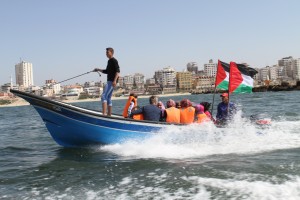 Traveling down the Gaza Coast, we witnessed again the lovely Mediterranean and the ugly pollution of the streams carrying untreated sewage into the sea. As we returned to Gaza City, the incomplete construction begun prior to the closure to the tunnels is evident everywhere.
Traveling down the Gaza Coast, we witnessed again the lovely Mediterranean and the ugly pollution of the streams carrying untreated sewage into the sea. As we returned to Gaza City, the incomplete construction begun prior to the closure to the tunnels is evident everywhere.
Our meeting with our hosts in the evening was joyful and most worked out a schedule for the work we will do in the week ahead. Work begins soon!!
(Gerri Haynes, former president of Washington Physicians for Social Responsibility, returned to Gaza with a delegation of doctors, nurses and others interested in helping the people there. Gerri has been sending back reports and this is her last one, at least until the next delegation.)
“Where are you from?” “Am’rika”, I reply.“Welcome, welcome”. Time and time again, the same warm, hospitable message.
My stay in Gaza started with the surreal witnessing at the Hamas border of the Islamic jihad and Mujahideens welcoming a prisoner back home to Gaza after having spent 27 years in an Israeli jail. Men in full balaclavas with Kalashnikovs, shots fired in the air in signs of happiness, family, journalists. We hadn’t asked for such a fervent welcoming committee… 😉
In the countryside, the peace sign is constantly flashed when we drive by. Yet Gaza is anything but peaceful. Torn to its core by continuous wars, the latest in November of 2012, Gaza is a place on edge, where people talk about their frustration with the government as well as with their neighbor Israel. The ever-present dust and destruction permeate my daily life, it exhausts me. Everywhere my eyes track, I see iron rods sticking out of concrete rubble, dirt and garbage everywhere, plastic bags flying, chaos—it’s inescapable, pervasive. Nothing is green. Graffiti covers almost every wall at every corner of the streets –it’s truly an art form intrinsic to Gaza—their unique message a plea for peace and the right to their land. It is exhausting and depressing. To my eyes, unused to war and destruction, the bombings could have happened yesterday – so intense is the devastation –yet to the ones who know, Gaza is purportedly doing some rebuilding. But many things have sadly just stayed the same here, or even gotten worse, paralyzed by systemic inefficiencies, political rifts and economic blockade.
With its 1.7 million inhabitants (most of them refugees)squeezed in less than 360km), Gaza is one of the most overcrowded places on earth. Blockaded since 2007 when Hamas gained power and controlled by the Israeli Defense Forces by air, sea and land, Gazans experience hardships very few can imagine: unable to leave, they remain in an open-air prison that boasts over 34% unemployment and 80% of its population on some form of aid. Compounding this situation are a fledgling infrastructure, severe electricity shortages, massive water issues, a struggling municipal service and a state of constant economic squeeze. You may understand a little better why peace is a difficult concept here.Yet, against this backdrop of people exhausted in the struggle to survive, their resilience and kindness take over. “We are so sorry for what happened in Boston”. How many times did I hear this message?
The cacophony of horns, generators or street vendors selling their goods to the passers-by signal that life still goes on in Gaza. Driving is mayhem, with cars weaving in whichever direction, honking their horn incessantly, asking whether you need a ride. I am the rare foreigner here—one of the only women in this sea of humanity who does not wear a scarf over my head. Walking in the streets in the old souk, I am undoubtedly noticed; the young men want a picture with me. “Welcome, welcome.”
I am their window to the outside. Every day, I have been touched by their gestures of generosity: the pita baker at the street corner invites me to make pita in his oven, and then gives me bread; my falafel hangout feeds me more falafels than I can digest – and wants to marry me; our staff at the hospital brought plates of fresh humus and olives for breakfast. They have kindly taught me Arabic words, enough that I can get my “café aulait” in the afternoon. I have been served more coffees and teas than I could dream of. At work in the hospital, they have taught me how much they can do with so little. They always readily share everything they have – and with a smile.
Even if deprived of their dignity, Gazans cannot stop having hope. It is their only option. And they know it all too well.Today was my last day at El Shifa hospital – today was a day of optimism. I witnessed two babies being born – two human beings who know nothing about war and conflict. As a new generation is born, each and every one of us, no matter our beliefs, owes it to them to have the right to a future as bright as ours. It is their right as human beings.
Kit Kittredge writes:
I found Palestinian resilience, resourcefulness and resistance alive in the streets and health facilities I worked in during this visit to Gaza.
The physiotherapy clinics are staffed with friendly, competent, committed staff doing great work and willing to share their knowledge and skills as well as learn some of ours. Additionally in the women’s and children’s clinics I found a very weary, stressed and anxious population. I saw many cases of children severely burned from gasoline and candle fires due to electricity shortages from Israel. I worked on children with missing limbs from explosives and phosphorous gas, and unwarranted amputations due to limited emergency care during Israeli attacks.
The illegal, immoral, barbaric siege of Gaza permeates every aspect of the medical community. The destruction of facilities, blockade of supplies, restricted access to definitive care, and the constant threat of an Israeli attack are horrific enough, but the psychological warfare is as destructive and intentional as the bombs.
Amidst the oppression and terror , the Palestinian spirit continues and the medical community works tirelessly and strives to meet the needs of the people. As always I am continually amazed, humbled and inspired by the people of Gaza. They are more than capable and willing to create a sustainable, peaceful, vibrant country if only we allow them to by helping end the U.S. supported Israeli blockade.Keith Meyer writes:
I worked with the physical therapy departments of El Waffa , Shiffa, and Public Aid hospitals and a private acupuncture clinic and found their staff and facilities well run. The staff was plentiful and well qualified but sadly there are not enough supplies or equipment to service the people’s needs due to the Israeli blockade, which is supported by Egypt and the U.S. The people I worked with and met on the street love life, family and friends.
After the Boston Marathon bombing all the therapists and doctors expressed their deepest sympathy and stated that they, of all people, understood our loss. As anticipated the people of Gaza were gracious, kind and generous. This was my first time in Gaza so there was some anxiety about what I would see versus what I have heard and read in the media.
The people of Gaza that I met and worked with hold education as very important. One Gazan said he was told by his grandparents, “You can lose your home, your land and all your possessions, but they can not take what you carry in your mind. You can take your education with you and use it anywhere.” This sentiment was echoed by all Gazans I spoke with. It saddened me to see the conditions in which they are forced to live, but I was inspired and moved by their resolve to work and live with integrity and love in their hearts.
And Bill Dienst writes:My first visit to Gaza was in 1985 and this is my seventh trip to the region. In the 80’s,there were no substantial physical barriers between Gaza and Israel. Many Gazans worked as day laborers in Israel and many spoke Hebrew. Group taxis traveled freely between East Jerusalem and the West Bank, and directly into Gaza City. The society here in Gaza was much moreWesternized and secularized than it is today. Women wore blue jeans and ponytails, and the hijab and the naqab were not nearly as ubiquitous as they are now. But it was hardly a perfect relationship between Israelis and Palestinians; more of a privileged class and servant class based on the birthright of whether or not one was born Jewish. But there was abundant interaction between the two societies then.
Then came the First Intifada (shaking off or uprising) and then the Oslo “Peace Process” which was really a “Piece Process.” This culminated in the division of the two societies and the isolation of Gaza from the rest of the world. There was false hope then and a second intifada. Gaza was locked down as a consequence and became the world’s largest prison.
When I re-entered Gaza some 18 years later in 2003, it was a much different world. Dr.Haidar Abdul Shafi, a respected physician and civic leader in Gaza, explained to me why he had walked out of the Madrid Peace negotiations in 1991. “I concluded that the Israelis we renegotiating in bad faith,” he said. It took me a while to fully understand what he was talking about, but slowly it became clearer. Gaza was now surrounded by a hideous “Berlin Wall”. Rachel Corrie had just been mowed down by a giant bulldozer. Houses and apartment blocks were being systematically destroyed under the orders of Ariel Sharon “to look for tunnels”. Many tunnels were found and destroyed, but even more tunnels were built in their place and remain today. More than2000 people in Rafah were made homeless as a direct result of Israel’s pursuit of the tunnels.
In 2006 I entered Gaza during a time of assault. The streets of Beit Hanoun were ripped apart after a Qassam missile had killed an Israeli woman in Sderot. More than 85 Palestinians were killed in Beit Hanoun and nineteen members of the Al Athamna family were massacred as they slept in their beds. Iinterviewed some of the grief stricken survivors a few days after the onslaught. Apache attack helicopters reigned death and destruction from the skies directly above us; we rushed to the Kamal Adwa Hospital to assist local doctors as 5 young men in their 20s died right in front of us. It was a time of palpable fear for me, as I shared for the first time, the fear that local Gazans feel routinely.In 2008, I entered Gaza by boat. I was part of the maiden voyage of the Free Gaza Movement; we were the first boats to arrive from international waters in 41 years. Gaza had been under a tightening siege. There were40,000 people on the shores of the Gaza Marina waiting to greet us. It was a time of euphoria as we demonstrated to the people of Gaza that many of us around the world have not forgotten them; many around the world who do care about them. There were several more boat trips and then flotillas. Then there was the massacre on the Mavi Marmara. My Italian friend Vittorio Arrigoni was martyred two years, and he is still remembered by the people of Gaza.
Then came the horror of Cast Lead. I last entered Gaza again in October2009 in its aftermath. The streets were filled with entire blocks of rubble; neighborhoods had been leveled; the siege had been tightened and there were no materials for rebuilding. Dr. Marwan Assalya, the general surgeon at Al Awda Hospital where we were assigned, shared horrific photographs of people he had cared for during the previous winter. There were pictures or victims of white phosphorus attacks with second, third and fourth degree burns all over their bodies. There were recipients of DIME weaponry whose arms were sheared off by vaporized micro-shrapnel. Patients who survived lingered, only to succumb later to sepsis; or if they survived in the short term, succumbed later to cancer – probably a direct result of the tungsten heavy metal vapor supplied by the U.S. arms industry. There were pictures of drone victims who had had both legs blown off; these were the survivors; there were no pictures of those who died immediately in the attacks.So now we are in Gaza. Our medical team disperses to various assignments. Dr. Bob Haynes and I are teaching elements of Advanced Cardiac Life Support at Shifa and Public Aid hospitals. We are giving lectures to very bright young medical and nursing students at Al Azhar and Islamic Universities.
We are being greeted by smiling and attentive students who still show hope and amazing resiliency for their future. In Gaza, hope springs eternal – Phoenix keeps rising miraculously from the ashes, especially among the youth.
But we will keep coming back as long as we can.
